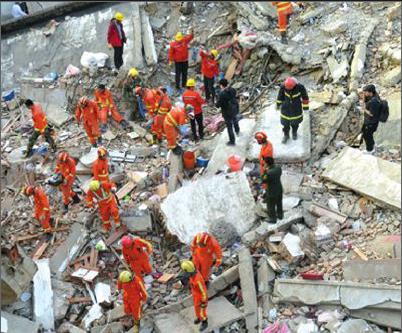Not Sturdy Enough
2014-05-08Byyuanyuan
By+yuan+yuan

A five-story residential building collapsed on the morning of April 4 in Fenghua of east Chinas Zhejiang Province despite being constructed only 20 years ago.
The collapse, which involved 15 households in Juding Community, happened at 8:45 am. Before the collapse, some residents had already become concerned by the sound of cracking coming from the building and swarmed downstairs. Unfortunately, seven people ultimately found themselves harmed by the collapse, including a 68-year-old senior, who later died in hospital. The other six survived.
Evidence that the building was dangerous had been noticed much earlier. In 2013, residents in the building reported that the walls were coming apart in chunks but they received no help and had to resort to repairing the walls on their own.
Things became even worse in October after Typhoon Fitow hit the area. Residents of 29 old buildings in Fenghua—including the one that collapsed—reported the worsening situation of their homes repeatedly. Finally, local authorities conducted a citywide safety inspection on the buildings. The building that eventually collapsed was identified as dangerous and needing reinforcement in December 2013. The reinforcements had not yet been carried out before the collapse, however.
Collapse Season
The incident in Fenghua has been the latest in a string of similar tragedies involving buildings and bridges throughout China since 2009.
A particularly high-profile case occurred in August 2009 when a two-story building built in the 1980s collapsed during a storm, killing 17 people in Shijiazhuang, capital of north Chinas Hebei Province. In September 2009, a five-story residential building collapsed in Ningbo, Zhejiang Province and three months later, another two-story building fell down in the same city. In March 2013, a four-story residential building collapsed in Shaoxing, Zhejiang Province.
All the buildings were built in the 1980s and 90s.
“In the 1980s and 90s, many apartment complexes were erected in a hurry to house the surging number of city dwellers under the countrys vigorous urbanization drive,” said yang Jianhua, a public policy researcher with the Zhejiang Provincial Academy of Social Sciences.
According to yang, lax supervision allowed developers, who wanted everything to be done as soon as possible, to cut corners. The establishment of standards lagged far behind the pace of construction and the use of inferior materials to lower costs also jeopardized the structural integrity of the homes being built.endprint
Chen Zairong, General Manager of Zhejiang Dingkun Construction Co. Ltd., said that during the peak season of construction, a large number of migrant laborers that worked on construction sites didnt even learn the ABCs of construction before climbing the scaffolding.
“Many workers skimped on steel and cement and some even used mud to replace mortar,” said Chen.
Zheng Fengtian, Deputy Dean of the Agricultural Economics and Rural Development School at the Renmin University of China said that the Fenghua building collapse is but one example of a wave of such accidents as the buildings constructed in the 1980s and 90s begin to age.
“According to the Property Law, a person enjoys property rights over real estate for 70 years, but many residential buildings seem to have a lifespan of only 50 years, after which they become too dangerous to live in. Some experts even say that some of the buildings are only good enough to last 25 years,” said Zheng. “Over the past few years, the public and the media have focused attention on rising housing prices, overlooking the importance of the safety that comes with the use of quality construction materials.”
Zheng explained that a real estate project is usually divided into three phases: design, construction and inspection for approval. Experts say quality is compromised mostly during the construction process. The problems, however, should be detected during inspection. But corruption and nepotism play a vital role in ensuring that the potential risks go either undetected or unreported.
“The use of inferior materials is not only a safety risk for residents, but also could lead to legal issues,” said Zheng. “With China experiencing a realty boom, it will be difficult for a homeowner to track down the original developer or construction company. In such cases, the family has to bear the loss if a building collapses.”
This is what happened with the collapsed Fenghua building. Although the cause of the accident is still under investigation, local government recently claimed it is difficult to find the responsible party because the company had broken up into four separate companies during the 1990s.
However, the government still tried to trace the liable parties, which are responsible for paying compensation to the victims. By April 8, two people associated with the construction of the buildings had been taken into custody.endprint
